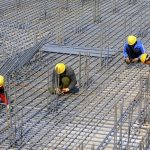 Every step from initial excavation to pouring the concrete is essential when building a foundation or structure platform. When properly executed, pouring a foundation will stay watertight regardless of the conditions outside and could last generations without costing you a dime in repair.
Every step from initial excavation to pouring the concrete is essential when building a foundation or structure platform. When properly executed, pouring a foundation will stay watertight regardless of the conditions outside and could last generations without costing you a dime in repair.
The foundation is the most important component to a building’s stability. The right foundation can easily expand and contract without fracturing. A number of components go into establishing a foundation that can withstand adverse conditions without deteriorating.
Resisting the combination of extreme moisture with wide-ranging temperatures is the definition of a well-built, long lasting foundation. This of course requires enlisting the services of a contractor which can initiate the knowledge and experience to account for fluctuating conditions and temperatures is crucial for foundation longevity and subsequent moneysaving.
Excavation
Every well-poured foundation sits atop properly excavated earth. Excavation is so much more than digging a trench and pouring cement. Each and every patch of earth has different levels of moisture, water table levels and soil stability, each requires individual attention and design. And because no two sections of earth are the same, there are no two excavation jobs are the same. This is why enlisting the services of a company experienced in making these kinds of assessments is monumental.
Once a trench is dug for a foundation but an excess of water is found pooling in the trench, for example, measures must be executed before any concrete can be poured. Though you can pour concrete in up to an inch of water, if it exceeds this level, cobbles should make up the base. Tightly compacting them provide bearing for the poured wall and prevent water damage. Taking factors such as these into account will prevent foundations from sagging, cracking and separating.
Masonry
Concrete block is the most common types of masonry in use. With unmatched compressive strength, mason block options are the most resilient to projectile debris, such as that from a tornado, and could last upward of thousand years under normal conditions. Additionally, filling concrete block cores with concrete- especially when in conjunction with steel rebar– can significantly increase lateral strength.
In addition to insurmountable strength and longevity, by default concrete block masonry adds to the thermal mass of a building. This means this type of foundation can actually protect the building from fire. Because it’s a non-combustible product, porous and impervious to extreme temperatures, concrete block walls are among the best options to protect an entire structure from an outside fire or as an interior fire wall.
Concrete Foundations
Once the excavation is complete, and any needed reinforcements are in place, you are ready to designate your foundation footers. Properly pouring a wall is as sensitive to specific conditions as is good excavating. That’s why knowing when to adjust footers accordingly is imperative to a trouble free structure. For example, when excavating and discovering a weak spot- thanks to such factors as clay layers- special measures must be taken. These can include doubling the width of your footers or pouring extra yards of depth.
Once your footers are established, the wall or slab concrete is ready for pouring. This requires boxing out the right forms and mixing the right cement ratio. Beyond the basics, professional touches are taken by more experienced outfits, such as slotting contraction joints every 4-6 feet and including an effective drainage path. These are all professional measures do-it-yourselfers or less advanced contractors are not as privy to.
Moisture is the bane of a structural foundation. Even a little moisture or water penetrating a foundation could bring down an entire structure or commercial building. The soundness of your concrete foundation is nothing to be left to an operation any less than professional. Professional foundation masons and services understand the nuances associated with the right steps and material to do a job right the first time.
Material alone is not what a manmade structure of any kind is composed of. Craftsmanship is more than half the battle for a well-designed, structurally-sound and long-lasting project. When something isn’t correctly built, it is more often than not the fault of builder rather than the material. So enlisting the services of a professional for any project- especially foundation installation or repair- is a must.

Leave a Reply